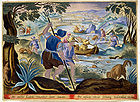- Makassan contact with Australia
-
Macassan or more correctly Makassar trepangers from the southwest corner of Sulawesi (formerly Celebes) visited the coast of northern Australia for hundreds of years to process trepang (also known as sea cucumber or "sandfish"): a marine invertebrate prized for its culinary and medicinal values in Chinese markets.
These visits have left their mark on the people of Northern Australia — in language, art[1], economy and even genetics in the descendants of both Makassar and Australian ancestors that are now found on both sides of the Arafura and Banda Seas.
Contents
The voyages
Historians are unsure as to when the journeys began from Makassar (also known as Ujung Pandang), to Marege',[2] the name the Makassar gave to northern coastal regions of Australia.[3] Trepang trade from Makassar appears to have begun around 1720, though some writers suggest the voyages began 300 years earlier (about 1400). The extent of their journeys ranged thousands of kilometers, from the Kimberley region of Western Australia to Mornington Island in the east of the Gulf of Carpentaria.
The trade began to dwindle toward the end of the 19th century due to the imposition of customs duties and licence fees by Australian governments that made it unviable, and after the introduction of legislation to protect Australia's "territorial integrity", the last Makassar perahu left Arnhem Land in 1906. Demand for trepang may have also dropped off due to unrest in China at the time.
Matthew Flinders in his circumnavigation of Australia in 1803 met the Makassar trading fleet near present day Nhulunbuy, an encounter that led to the establishment of settlements on Melville Island and the Coburg Peninsula.
Fishing and processing of Trepang
Trepang lie motionless on the sea floor and are exposed at low tide. Fishing was done by hand, spearing, diving or dredging. The catch was placed in boiling water before being dried and smoked, to preserve the trepang for the long journey back to Makassar and other South East Asian markets, to eventually end up in China. Trepang is valued by Chinese for its jelly-like texture, its flavour-enhancing properties, and as a stimulant and aphrodisiac.
Archeological remains of Makassar processing plants from the 18th and 19th centuries are still at Port Essington, Anuru Bay and Groote Eylandt, along with stands of the Makassar-introduced tamarind trees.
Effect on peoples of Australia
While markedly different from their experience of colonisation by the British, the Makassar contact with Aboriginal people had a significant effect on their cultures. The visits are remembered vividly today, through oral history, songs and dances, and rock and bark paintings, as well as the cultural legacy of transformations that resulted from the contact.
The Makassar exchanged goods such as cloth, tobacco, knives, rice and alcohol for the right to fish in Aboriginal waters, and employ Aboriginals as labourers. Such products brought with them new opportunities as well as new challenges, such as the dangerous combination of knives and alcohol.
Some Yolngu communities of Arnhem land re-figured their economies from being largely land-based to largely sea-based with the introduction of Makassar technologies such as dug-out canoes. These seaworthy boats, unlike their traditional bark canoes, allowed Yolngu to fish the ocean for dugongs and turtles.
Some Aboriginal workers willingly accompanied the Makassar back to their homeland of South Sulawesi, Indonesia across the Arafura Sea. The Yolngu people also remember with grief the abductions and trading of Yolngu women, and the introduction of smallpox, which was epidemic in the islands east of Java at the time.[citation needed]
A Makassar pidgin became a lingua franca along the north coast, not just between Makassar and Aboriginal people, but also between different Aboriginal groups, who were brought into greater contact with each other by the seafaring Makassar culture. Words from the Makassar language (related to Javanese and Indonesian) can still be found in Aboriginal language varieties of the north coast; examples include rupiah (money), jama (work), and balanda (white person), which originally came to the Makassar language via the Malay 'orang belanda' meaning dutch people from the root word for swamp. Some of the goods traded by the Makassar spread far across the country, even to the south.
The Makassar may have also been the first to bring religion in the form of Islam to Australia.[4]
Current situation
Though prevented from fishing across Arnhem Land, other Indonesian fishermen have continued to fish up and down the west coast, in what are now Australian waters, as they have done for hundreds of years before such territories were declared — some in traditional boats that their grandparents owned. Such fishing is considered illegal by the present-day Australian government, and since the 1970s, if caught by authorities, the boats are burned and the fishermen are returned to Indonesia. Most Indonesian fishing in Australian waters now occurs around what Australia coined "Ashmore Reef" (known in Indonesia as Pulau Pasir) and the nearby islands.
See also
- Trepanging
- History of Australia before 1901
- Yolngu
- Theory of Portuguese discovery of Australia
- Baijini - legendary people interpreted by some researchers as pre-Macassan visitors to Arnhem Land.[5]
Notes
- ^ The Rock Art That Redraws Our History (SMH, 2008)
- ^ Note that the name, strictly speaking, is spelt "Marege'", with an accent after the second "e".
- ^ MacKnight, CC (1976).The Voyage to Marege: Macassan Trepangers in Northern Australia. Melbourne University Press
- ^ Article about Islam in Australia
- ^ Berndt, Ronald M. (2005) [1952], Djanggawul: An Aboriginal Religious Cult of North-Eastern Arnhem Land, Volume 43 of Routledge library editions: Anthropology and ethnography, Routledge, p. 55, ISBN 041533022X, http://books.google.com/books?id=a3WrtxazTRkC
References
- McIntosh, I. S. (2000) Aboriginal Reconciliation and the Dreaming. Allyn and Bacon, Boston.
Categories:- History of Indigenous Australians
- History of Australia before 1788
- Maritime history of Australia
- History of Indonesia
- Fishing communities in Australia
- Fishing in Australia
Wikimedia Foundation. 2010.



